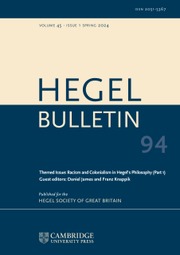Article contents
Adorno’s Wrong Life Claim and the Concept of Despair
Published online by Cambridge University Press: 17 October 2016
Abstract
Adorno’s critical theory is distinguished by his affirming what I call the ‘Wrong Life Claim’ (WLC), the claim that everything in existence exhibits wrongness or badness. This claim is notoriously hard to justify. The WLC, as I describe it, appears to rest on two things: the first is a form of Hegelian social holism; the second is some experience of or fundamental orientation towards reality which can motivate an ‘inversion’ of said holism. In this paper, I will leave aside questions of whether Hegelian holism is itself justified, and instead focus my efforts on convincing already-convinced Hegelians of the plausibility of the WLC. My argument is that we can formulate a version of the WLC that stands a chance of convincing ‘the Hegelian’ by focusing on the Kierkegaardian heritage of Adorno’s ideas: specifically, by understanding Adornian ‘wrongness’ to be analogous to ‘despair’, a concept which Kierkegaard explores at length in The Sickness Unto Death.
- Type
- Articles
- Information
- Copyright
- © The Hegel Society of Great Britain 2016
References
- 1
- Cited by


